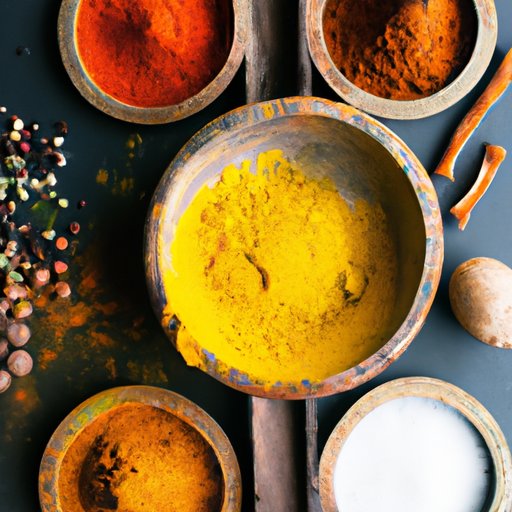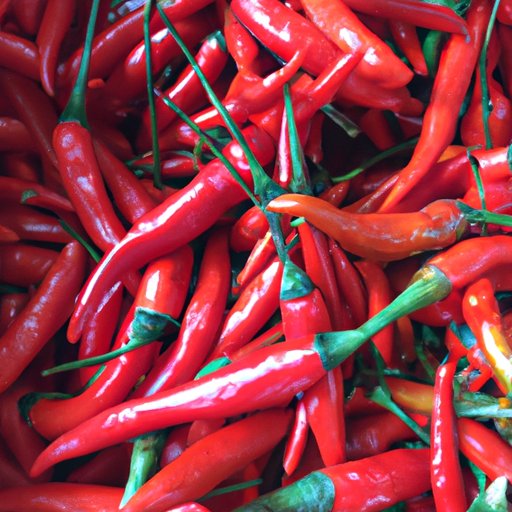Introduction
Spicy food is a popular topic around the world. From hot sauce challenges to daring regional cuisines, people love exploring the different flavors and intensities of spicy food. But what is it about spice that draws us in? The purpose of this article is to explore the physical, cultural, and psychological aspects of spice and why people love spicy food.
The Science behind the Spice: Understanding the Physical and Emotional Effects of Eating Spicy Food
Spicy food gets its intense heat from capsaicin, a compound found in chili peppers. When capsaicin comes in contact with the tongue, it activates pain receptors, which send signals to the brain that simulate the sensation of heat. These signals trigger the body’s natural response to pain and heat, such as sweating and increased heart rate.
Additionally, consuming spicy food can have emotional effects on the body. Spicy food has been known to release endorphins, the body’s natural painkillers, which can create feelings of euphoria and pleasure. This is why some people find eating spicy food to be an enjoyable and addictive experience.
Some popular spicy foods include hot sauce, kimchi, buffalo wings, and vindaloo curry. Each of these foods has its own distinct flavor and heat level, and each affects the body differently. For example, kimchi is a fermented dish that combines spicy and sour flavors and has been linked to improved gut health. Buffalo wings are often served with a cooling dip, which can help alleviate the heat of the spicy sauce.
The History of Spice: A Flavorful Journey through Cultures and Cuisines
Spice has been around for centuries, and its history is intertwined with the cultures and cuisines of the world. Spice was once a rare and exotic commodity, traded across vast distances and used for its medicinal qualities as well as its culinary applications. In ancient Egypt, it was used in the embalming process, while in China, it was used to treat a variety of ailments.
Spice played a significant role in the development of world cuisine. Dishes like Indian curries, Mexican salsa, and Chinese hot pot all rely on spice to create their distinct flavors. Each culture has its own unique spice blends and recipes that reflect the local cuisine and flavor preferences.
Despite the global popularity of spicy food, different regions of the world have different levels of spice tolerance. For example, in India and Thailand, spicy food is a common part of daily cuisine, while in Europe and North America, spice is often used more sparingly. This reflects cultural differences in taste preferences and spice tolerance.
Dare to be Different: Exploring the Fascination with Unique and Exotic Flavors in Spicy Foods
People are often drawn to unique and exotic flavors, and spicy food is no exception. In fact, many people seek out spicy foods specifically for their unique and complex flavors. For example, different varieties of chili peppers can have vastly different flavors, from sweet and fruity to smoky and savory. Additionally, spices can be used to accentuate other flavors in a dish, such as the way cumin adds depth to a Mexican mole sauce.
There are many exotic spicy dishes from around the world that showcase unique and complex flavor profiles. For example, Ethiopian doro wat is a spicy stew made with chicken, berbere spice, and vegetable and is often served with injera bread. Korean bibimbap is a rice bowl topped with seasoned vegetables, gochujang sauce, and a fried egg.
Heat and Health: The Benefits and Risks of Consuming Spicy Foods
Consuming spicy food can have potential health benefits. Studies have shown that chili peppers may improve digestion, boost metabolism, and reduce inflammation. Additionally, some research suggests that capsaicin may help reduce the risk of chronic diseases, such as heart disease and cancer.
However, consuming spicy food can also have potential risks. Spicy food can exacerbate digestive issues, such as heartburn and irritable bowel syndrome (IBS), in some individuals. It can also cause sweating, flushed skin, and other uncomfortable symptoms in those who are sensitive to spicy food.
For those who want to enjoy the health benefits of spicy food without the potential risks, there are several tips to keep in mind. Eating smaller portions of spicy food, consuming it in moderation, and pairing it with cooling foods, such as yogurt or rice, can help alleviate the heat and potential digestive issues.
The Psychology of Spice: Why Some People Crave the Burn and Others Can’t Stand It
Some people are more drawn to spicy food than others, and there are several factors that can influence spice preference. Genetics plays a role in spice preference, with some individuals being genetically predisposed to enjoy spicy foods. Additionally, cultural factors can influence spice preference, with some cultures having a higher tolerance for spice than others.
Personality can also play a role in spice preference. People who enjoy thrill-seeking activities and have a high tolerance for risk are often more drawn to spicy foods. Conversely, people who tend to avoid risk and prefer familiar flavors may be less likely to enjoy spicy foods.
Despite these differences in spice preference, there is something universal about the pleasure of consuming spicy food. Whether it’s the thrill of the burn or the unique flavor combinations, there’s no denying that spicy food is a unique and enjoyable sensory experience.

The Spice of Life: Celebrating the Diversity and Complexity of Spicy Dishes around the World
Spicy food is an integral part of world cuisine, and its diversity and complexity are worth celebrating. From the humble chili pepper to complex spice blends and unique flavor combinations, spicy food offers something for everyone. Whether you’re a heat-seeker or a spice novice, there’s always something new and exciting to discover in the world of spicy food.
So why not embrace the spice and try some new dishes? Whether you’re trying a new spicy sauce or indulging in an exotic spicy dish, there’s always a new flavor adventure to be had.
The Quest for the Hottest Pepper on Earth: A Thrilling Adventure through the Sizzling World of Competitive Spicy Food
For the truly daring, there’s the world of competitive spicy food. From hot sauce drinking contests to chili pepper eating challenges, there’s no shortage of ways to test your spice tolerance. But be warned, some of these challenges can be dangerous and should only be attempted by experienced spice enthusiasts.
Some popular spicy food challenges include the Carolina Reaper Challenge (consuming the world’s hottest chili pepper) and the Hot Sauce Challenge (consuming increasing levels of hot sauce until you tap out). These challenges can be thrilling and exciting for those who enjoy an extreme sensory experience, but they should always be approached with caution.
Conclusion
Spicy food is an enjoyable and complex sensory experience that offers a variety of physical, cultural, and psychological benefits. Whether you’re a heat-seeker or a spice novice, there’s always something new to discover in the world of spicy food. So go ahead, embrace the spice, and try some new dishes. Who knows, you might just find your new favorite flavor.
